Business Analysis S1 2018: Medigood Information System Development
VerifiedAdded on 2023/06/11
|14
|2453
|178
Case Study
AI Summary
This case study solution focuses on the development of a new information system for Medigood, a healthcare insurance company, to address existing issues and improve doctor consultation management. It includes a work breakdown structure outlining project activities and timelines, a 'to-be' design activity diagram illustrating the new system's core business processes, and an analysis of the organizational changes required for successful implementation. The solution also covers screen designs for new users and specialists, acceptance criteria for the system, and an application architecture framework. A report to the client details the decision-making process for system development, emphasizing in-house development and the use of the Waterfall model. Finally, it compares the Agile and Waterfall methodologies, highlighting their pros and cons in the context of software development. Desklib offers a wealth of similar resources for students.
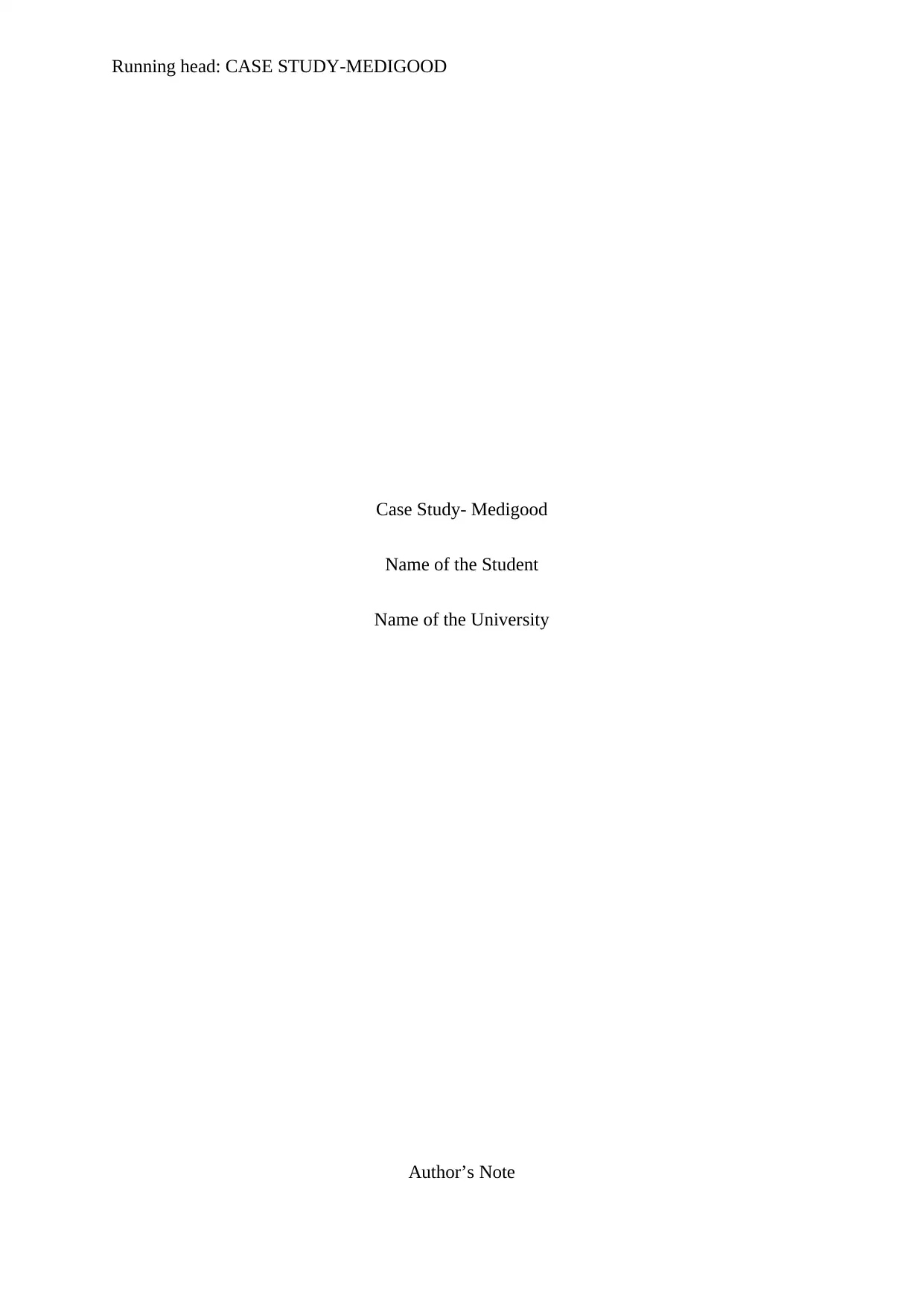
Running head: CASE STUDY-MEDIGOOD
Case Study- Medigood
Name of the Student
Name of the University
Author’s Note
Case Study- Medigood
Name of the Student
Name of the University
Author’s Note
Paraphrase This Document
Need a fresh take? Get an instant paraphrase of this document with our AI Paraphraser
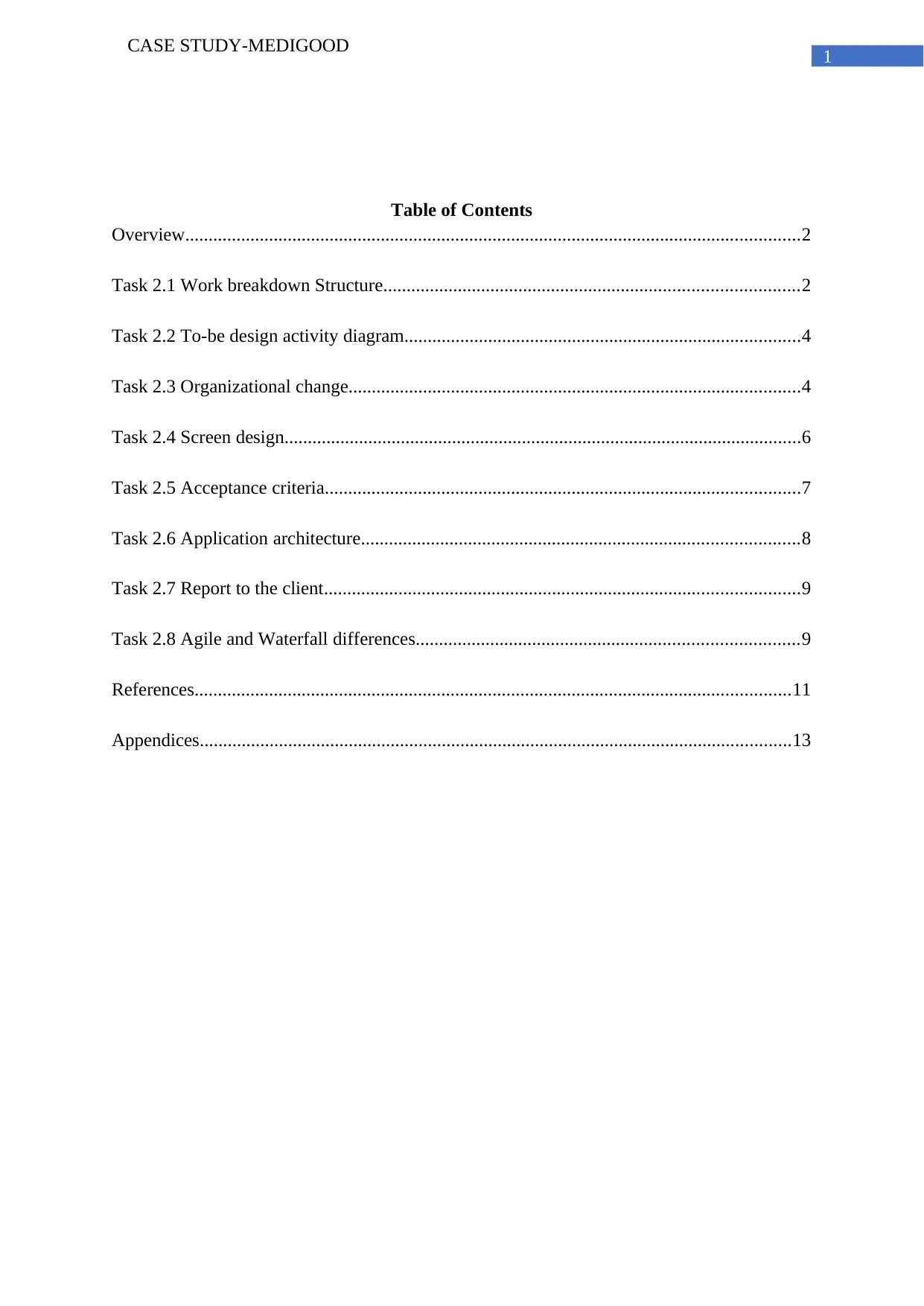
1
CASE STUDY-MEDIGOOD
Table of Contents
Overview....................................................................................................................................2
Task 2.1 Work breakdown Structure.........................................................................................2
Task 2.2 To-be design activity diagram.....................................................................................4
Task 2.3 Organizational change.................................................................................................4
Task 2.4 Screen design...............................................................................................................6
Task 2.5 Acceptance criteria......................................................................................................7
Task 2.6 Application architecture..............................................................................................8
Task 2.7 Report to the client......................................................................................................9
Task 2.8 Agile and Waterfall differences..................................................................................9
References................................................................................................................................11
Appendices...............................................................................................................................13
CASE STUDY-MEDIGOOD
Table of Contents
Overview....................................................................................................................................2
Task 2.1 Work breakdown Structure.........................................................................................2
Task 2.2 To-be design activity diagram.....................................................................................4
Task 2.3 Organizational change.................................................................................................4
Task 2.4 Screen design...............................................................................................................6
Task 2.5 Acceptance criteria......................................................................................................7
Task 2.6 Application architecture..............................................................................................8
Task 2.7 Report to the client......................................................................................................9
Task 2.8 Agile and Waterfall differences..................................................................................9
References................................................................................................................................11
Appendices...............................................................................................................................13
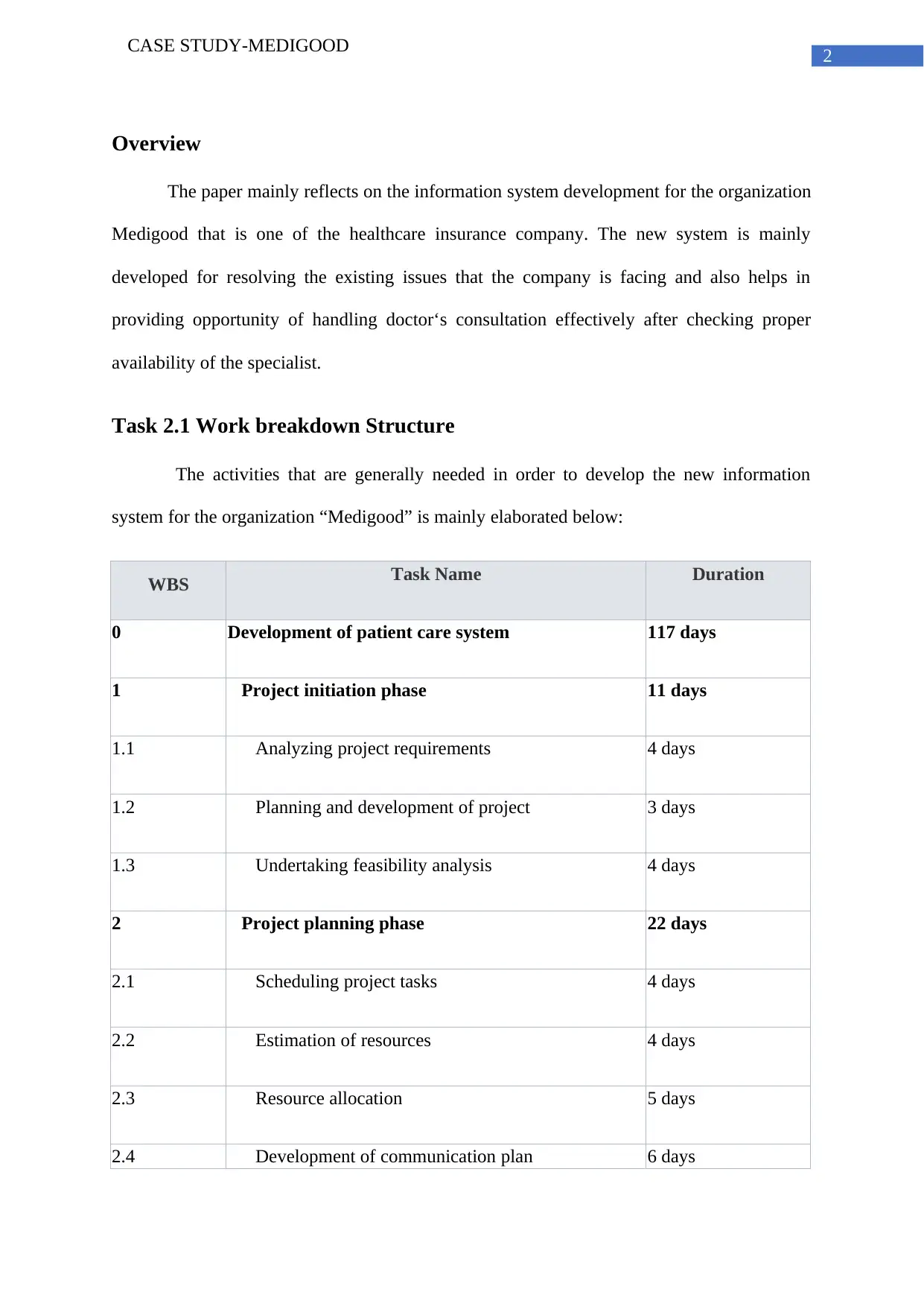
2
CASE STUDY-MEDIGOOD
Overview
The paper mainly reflects on the information system development for the organization
Medigood that is one of the healthcare insurance company. The new system is mainly
developed for resolving the existing issues that the company is facing and also helps in
providing opportunity of handling doctor‘s consultation effectively after checking proper
availability of the specialist.
Task 2.1 Work breakdown Structure
The activities that are generally needed in order to develop the new information
system for the organization “Medigood” is mainly elaborated below:
WBS Task Name Duration
0 Development of patient care system 117 days
1 Project initiation phase 11 days
1.1 Analyzing project requirements 4 days
1.2 Planning and development of project 3 days
1.3 Undertaking feasibility analysis 4 days
2 Project planning phase 22 days
2.1 Scheduling project tasks 4 days
2.2 Estimation of resources 4 days
2.3 Resource allocation 5 days
2.4 Development of communication plan 6 days
CASE STUDY-MEDIGOOD
Overview
The paper mainly reflects on the information system development for the organization
Medigood that is one of the healthcare insurance company. The new system is mainly
developed for resolving the existing issues that the company is facing and also helps in
providing opportunity of handling doctor‘s consultation effectively after checking proper
availability of the specialist.
Task 2.1 Work breakdown Structure
The activities that are generally needed in order to develop the new information
system for the organization “Medigood” is mainly elaborated below:
WBS Task Name Duration
0 Development of patient care system 117 days
1 Project initiation phase 11 days
1.1 Analyzing project requirements 4 days
1.2 Planning and development of project 3 days
1.3 Undertaking feasibility analysis 4 days
2 Project planning phase 22 days
2.1 Scheduling project tasks 4 days
2.2 Estimation of resources 4 days
2.3 Resource allocation 5 days
2.4 Development of communication plan 6 days
⊘ This is a preview!⊘
Do you want full access?
Subscribe today to unlock all pages.

Trusted by 1+ million students worldwide
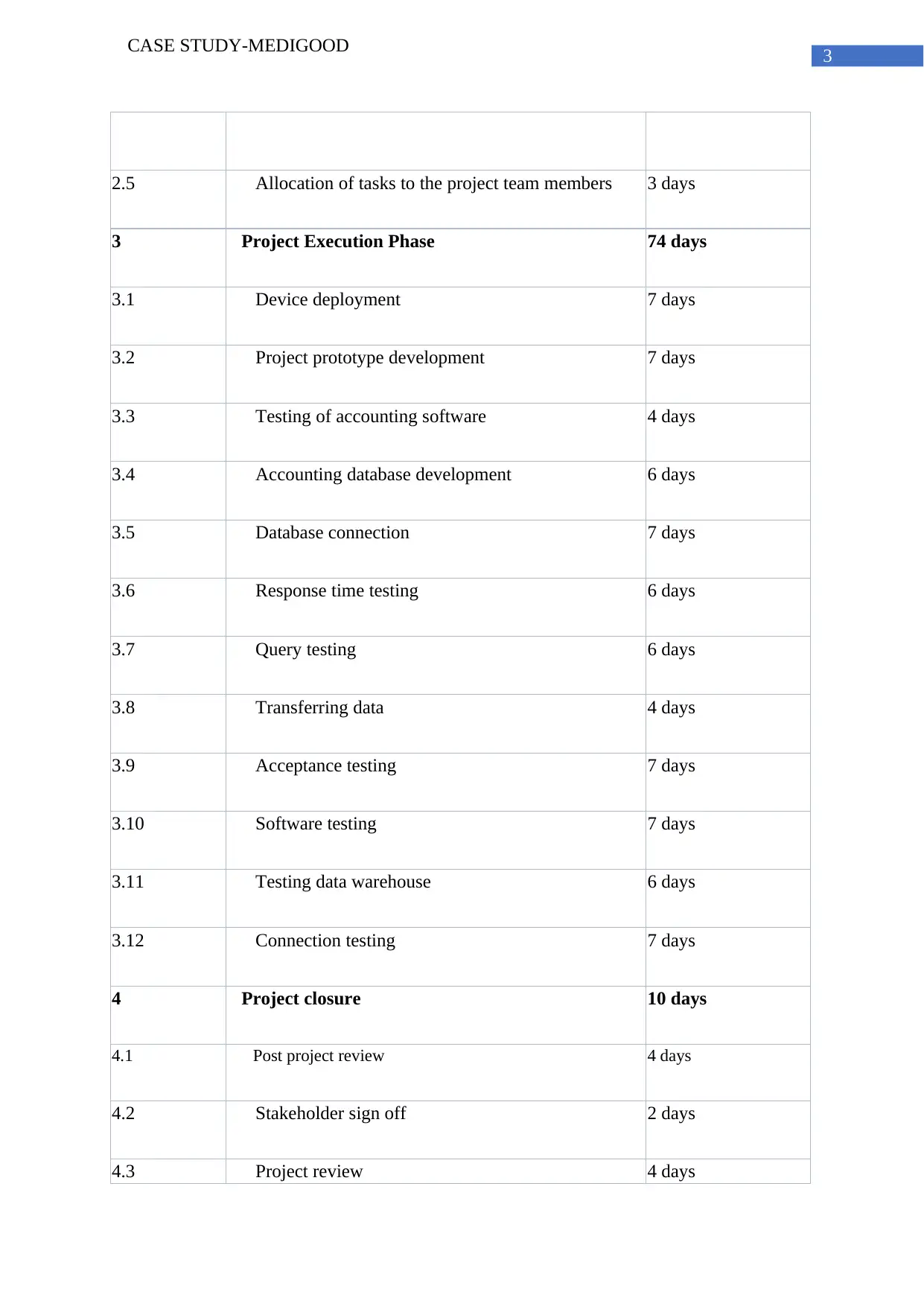
3
CASE STUDY-MEDIGOOD
2.5 Allocation of tasks to the project team members 3 days
3 Project Execution Phase 74 days
3.1 Device deployment 7 days
3.2 Project prototype development 7 days
3.3 Testing of accounting software 4 days
3.4 Accounting database development 6 days
3.5 Database connection 7 days
3.6 Response time testing 6 days
3.7 Query testing 6 days
3.8 Transferring data 4 days
3.9 Acceptance testing 7 days
3.10 Software testing 7 days
3.11 Testing data warehouse 6 days
3.12 Connection testing 7 days
4 Project closure 10 days
4.1 Post project review 4 days
4.2 Stakeholder sign off 2 days
4.3 Project review 4 days
CASE STUDY-MEDIGOOD
2.5 Allocation of tasks to the project team members 3 days
3 Project Execution Phase 74 days
3.1 Device deployment 7 days
3.2 Project prototype development 7 days
3.3 Testing of accounting software 4 days
3.4 Accounting database development 6 days
3.5 Database connection 7 days
3.6 Response time testing 6 days
3.7 Query testing 6 days
3.8 Transferring data 4 days
3.9 Acceptance testing 7 days
3.10 Software testing 7 days
3.11 Testing data warehouse 6 days
3.12 Connection testing 7 days
4 Project closure 10 days
4.1 Post project review 4 days
4.2 Stakeholder sign off 2 days
4.3 Project review 4 days
Paraphrase This Document
Need a fresh take? Get an instant paraphrase of this document with our AI Paraphraser
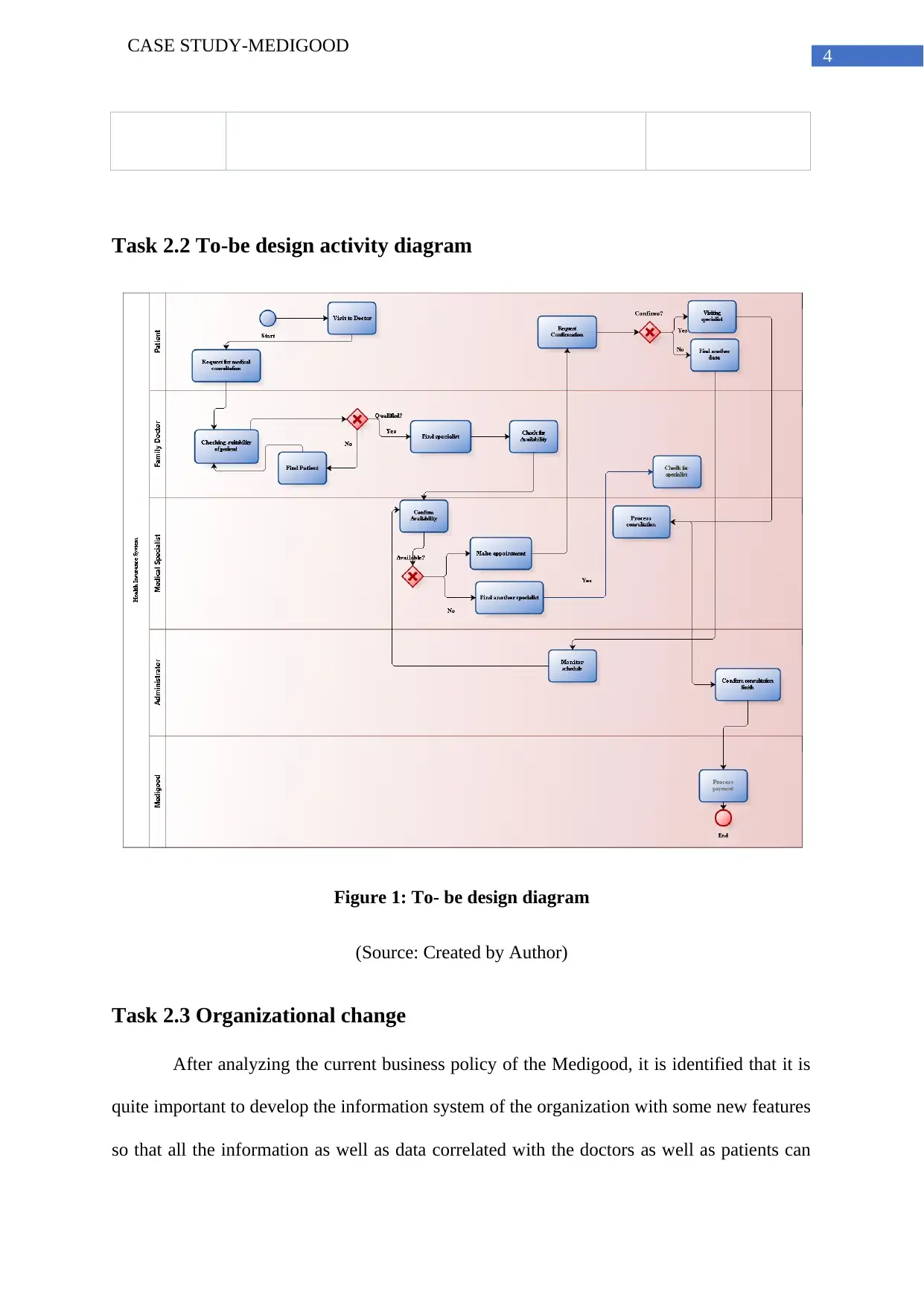
4
CASE STUDY-MEDIGOOD
Task 2.2 To-be design activity diagram
Figure 1: To- be design diagram
(Source: Created by Author)
Task 2.3 Organizational change
After analyzing the current business policy of the Medigood, it is identified that it is
quite important to develop the information system of the organization with some new features
so that all the information as well as data correlated with the doctors as well as patients can
CASE STUDY-MEDIGOOD
Task 2.2 To-be design activity diagram
Figure 1: To- be design diagram
(Source: Created by Author)
Task 2.3 Organizational change
After analyzing the current business policy of the Medigood, it is identified that it is
quite important to develop the information system of the organization with some new features
so that all the information as well as data correlated with the doctors as well as patients can
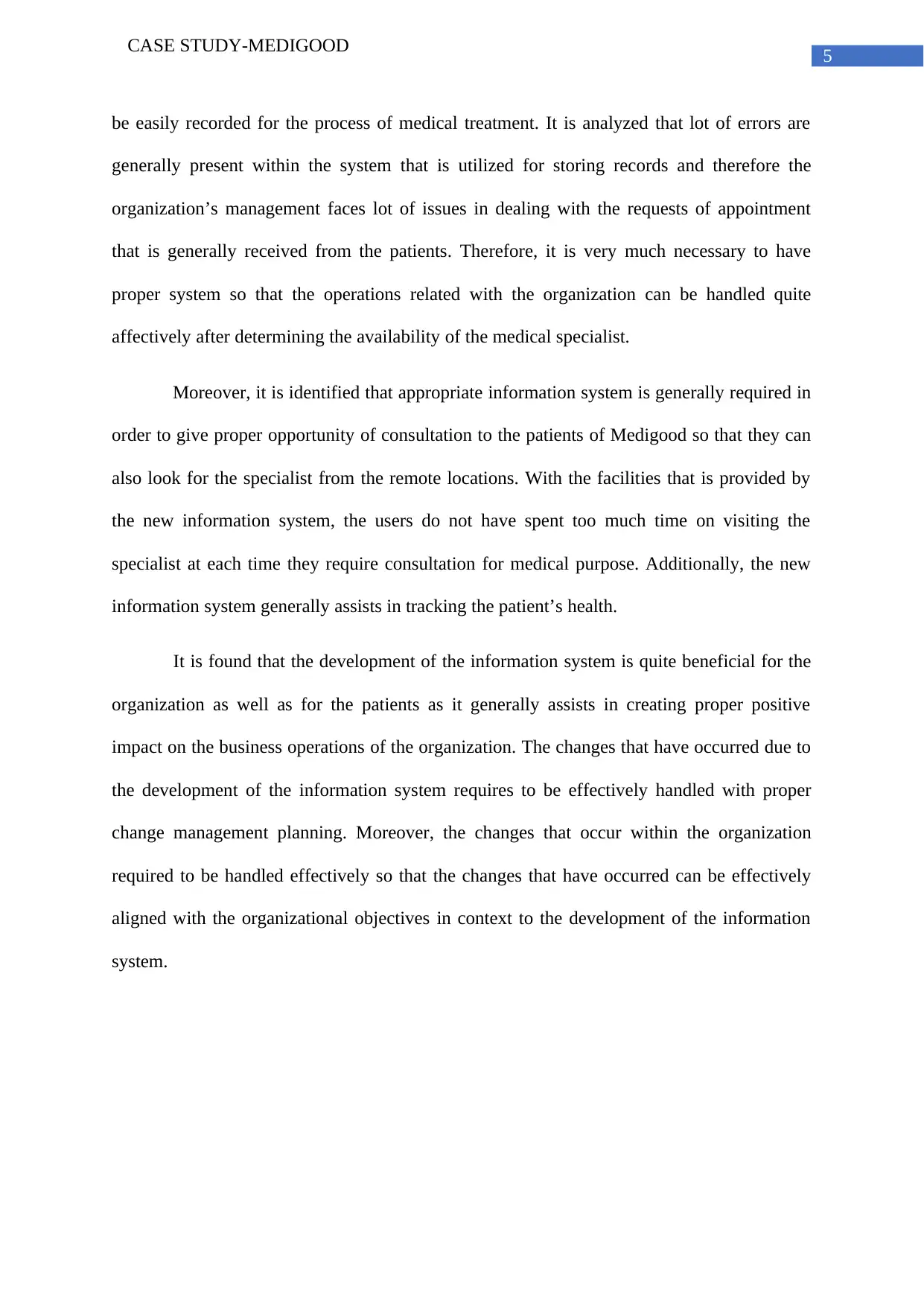
5
CASE STUDY-MEDIGOOD
be easily recorded for the process of medical treatment. It is analyzed that lot of errors are
generally present within the system that is utilized for storing records and therefore the
organization’s management faces lot of issues in dealing with the requests of appointment
that is generally received from the patients. Therefore, it is very much necessary to have
proper system so that the operations related with the organization can be handled quite
affectively after determining the availability of the medical specialist.
Moreover, it is identified that appropriate information system is generally required in
order to give proper opportunity of consultation to the patients of Medigood so that they can
also look for the specialist from the remote locations. With the facilities that is provided by
the new information system, the users do not have spent too much time on visiting the
specialist at each time they require consultation for medical purpose. Additionally, the new
information system generally assists in tracking the patient’s health.
It is found that the development of the information system is quite beneficial for the
organization as well as for the patients as it generally assists in creating proper positive
impact on the business operations of the organization. The changes that have occurred due to
the development of the information system requires to be effectively handled with proper
change management planning. Moreover, the changes that occur within the organization
required to be handled effectively so that the changes that have occurred can be effectively
aligned with the organizational objectives in context to the development of the information
system.
CASE STUDY-MEDIGOOD
be easily recorded for the process of medical treatment. It is analyzed that lot of errors are
generally present within the system that is utilized for storing records and therefore the
organization’s management faces lot of issues in dealing with the requests of appointment
that is generally received from the patients. Therefore, it is very much necessary to have
proper system so that the operations related with the organization can be handled quite
affectively after determining the availability of the medical specialist.
Moreover, it is identified that appropriate information system is generally required in
order to give proper opportunity of consultation to the patients of Medigood so that they can
also look for the specialist from the remote locations. With the facilities that is provided by
the new information system, the users do not have spent too much time on visiting the
specialist at each time they require consultation for medical purpose. Additionally, the new
information system generally assists in tracking the patient’s health.
It is found that the development of the information system is quite beneficial for the
organization as well as for the patients as it generally assists in creating proper positive
impact on the business operations of the organization. The changes that have occurred due to
the development of the information system requires to be effectively handled with proper
change management planning. Moreover, the changes that occur within the organization
required to be handled effectively so that the changes that have occurred can be effectively
aligned with the organizational objectives in context to the development of the information
system.
⊘ This is a preview!⊘
Do you want full access?
Subscribe today to unlock all pages.

Trusted by 1+ million students worldwide
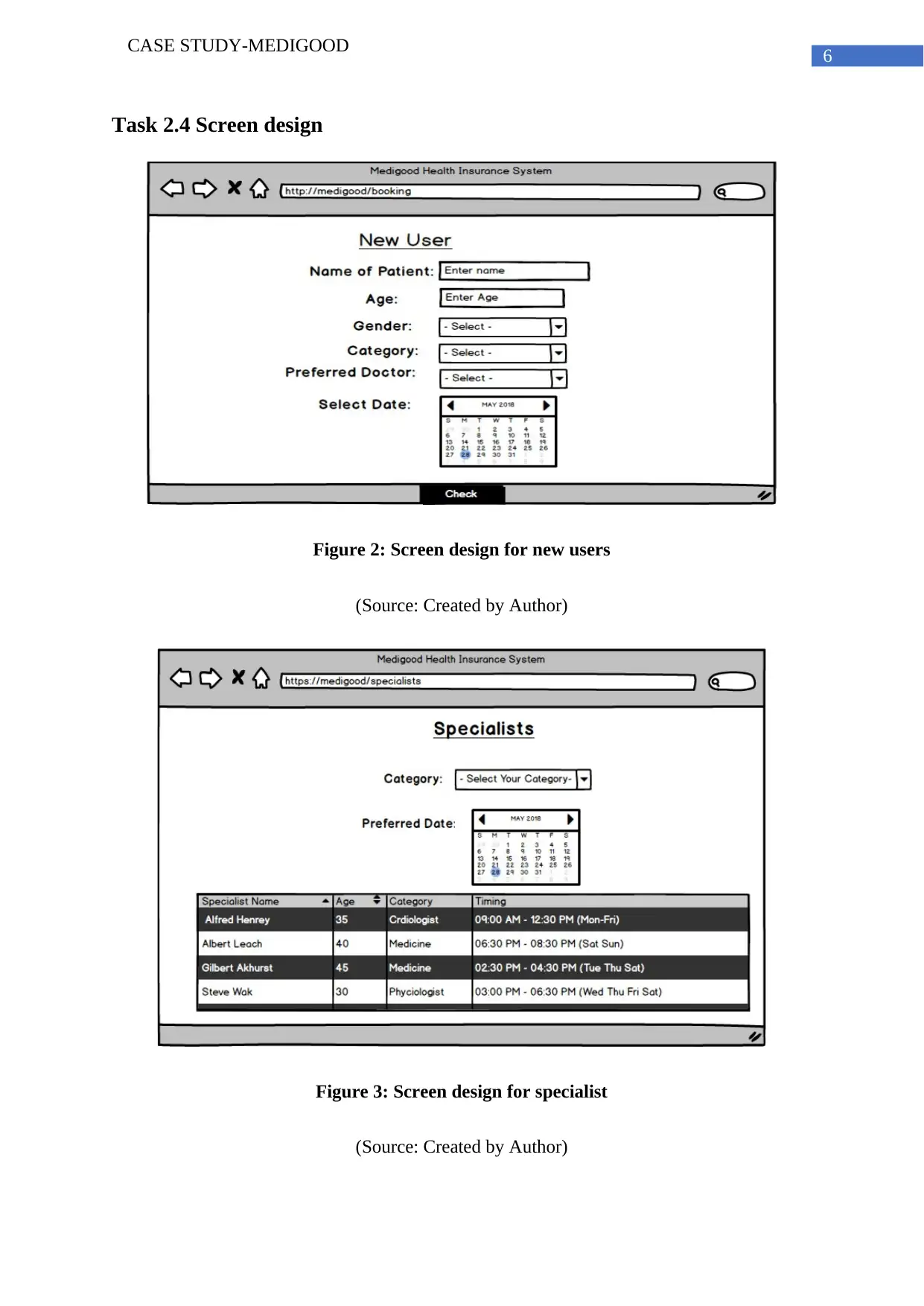
6
CASE STUDY-MEDIGOOD
Task 2.4 Screen design
Figure 2: Screen design for new users
(Source: Created by Author)
Figure 3: Screen design for specialist
(Source: Created by Author)
CASE STUDY-MEDIGOOD
Task 2.4 Screen design
Figure 2: Screen design for new users
(Source: Created by Author)
Figure 3: Screen design for specialist
(Source: Created by Author)
Paraphrase This Document
Need a fresh take? Get an instant paraphrase of this document with our AI Paraphraser
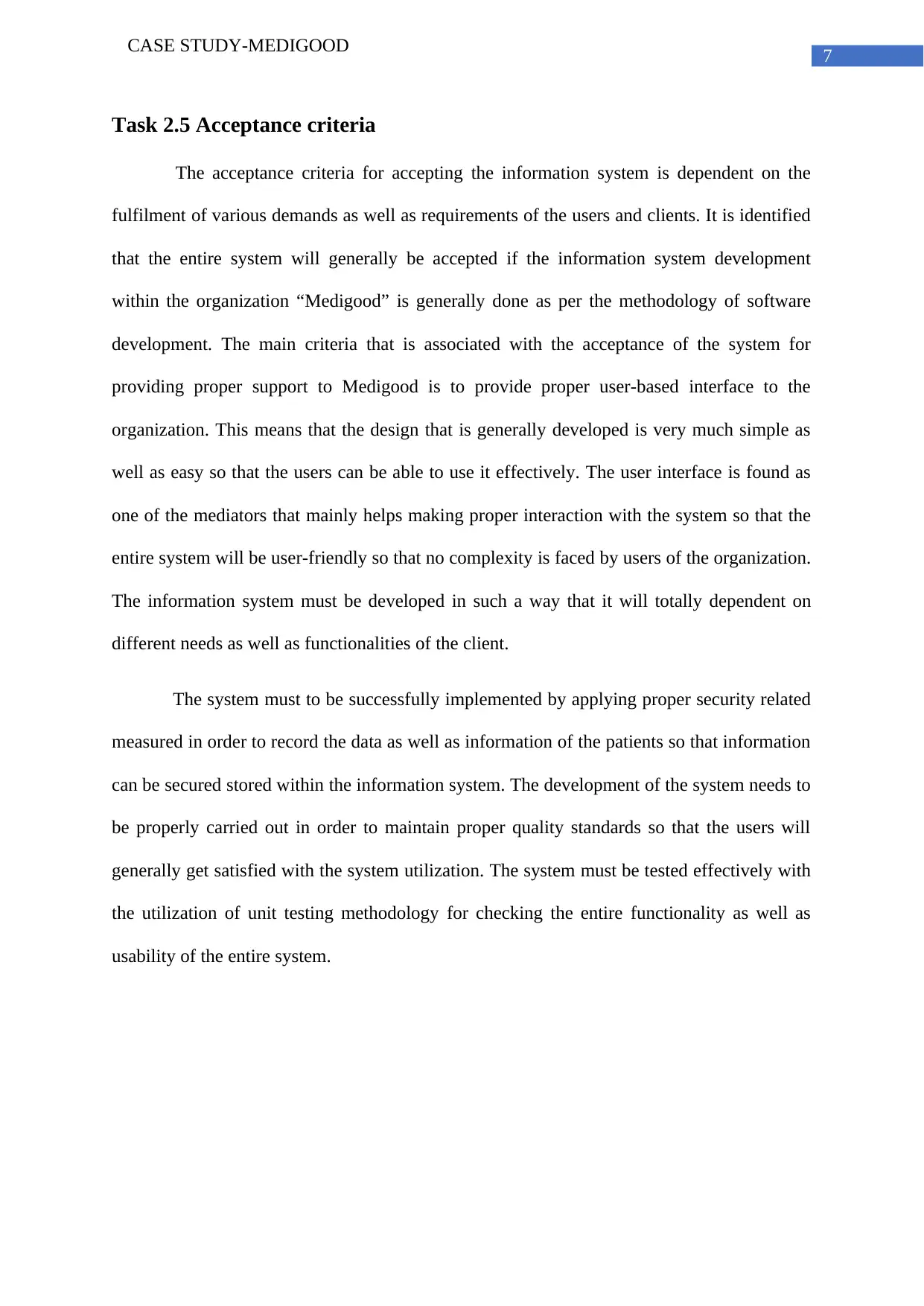
7
CASE STUDY-MEDIGOOD
Task 2.5 Acceptance criteria
The acceptance criteria for accepting the information system is dependent on the
fulfilment of various demands as well as requirements of the users and clients. It is identified
that the entire system will generally be accepted if the information system development
within the organization “Medigood” is generally done as per the methodology of software
development. The main criteria that is associated with the acceptance of the system for
providing proper support to Medigood is to provide proper user-based interface to the
organization. This means that the design that is generally developed is very much simple as
well as easy so that the users can be able to use it effectively. The user interface is found as
one of the mediators that mainly helps making proper interaction with the system so that the
entire system will be user-friendly so that no complexity is faced by users of the organization.
The information system must be developed in such a way that it will totally dependent on
different needs as well as functionalities of the client.
The system must to be successfully implemented by applying proper security related
measured in order to record the data as well as information of the patients so that information
can be secured stored within the information system. The development of the system needs to
be properly carried out in order to maintain proper quality standards so that the users will
generally get satisfied with the system utilization. The system must be tested effectively with
the utilization of unit testing methodology for checking the entire functionality as well as
usability of the entire system.
CASE STUDY-MEDIGOOD
Task 2.5 Acceptance criteria
The acceptance criteria for accepting the information system is dependent on the
fulfilment of various demands as well as requirements of the users and clients. It is identified
that the entire system will generally be accepted if the information system development
within the organization “Medigood” is generally done as per the methodology of software
development. The main criteria that is associated with the acceptance of the system for
providing proper support to Medigood is to provide proper user-based interface to the
organization. This means that the design that is generally developed is very much simple as
well as easy so that the users can be able to use it effectively. The user interface is found as
one of the mediators that mainly helps making proper interaction with the system so that the
entire system will be user-friendly so that no complexity is faced by users of the organization.
The information system must be developed in such a way that it will totally dependent on
different needs as well as functionalities of the client.
The system must to be successfully implemented by applying proper security related
measured in order to record the data as well as information of the patients so that information
can be secured stored within the information system. The development of the system needs to
be properly carried out in order to maintain proper quality standards so that the users will
generally get satisfied with the system utilization. The system must be tested effectively with
the utilization of unit testing methodology for checking the entire functionality as well as
usability of the entire system.
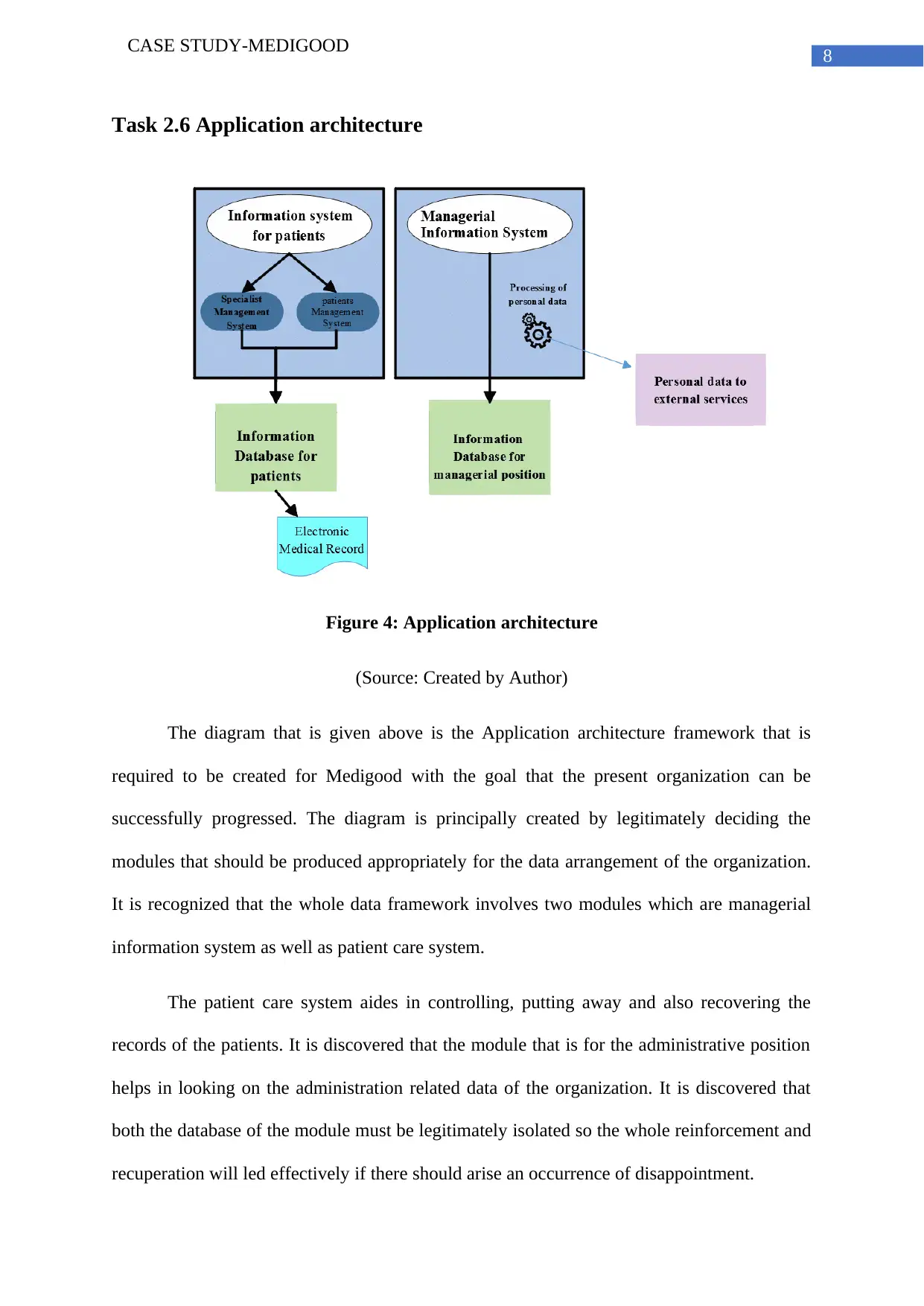
8
CASE STUDY-MEDIGOOD
Task 2.6 Application architecture
Figure 4: Application architecture
(Source: Created by Author)
The diagram that is given above is the Application architecture framework that is
required to be created for Medigood with the goal that the present organization can be
successfully progressed. The diagram is principally created by legitimately deciding the
modules that should be produced appropriately for the data arrangement of the organization.
It is recognized that the whole data framework involves two modules which are managerial
information system as well as patient care system.
The patient care system aides in controlling, putting away and also recovering the
records of the patients. It is discovered that the module that is for the administrative position
helps in looking on the administration related data of the organization. It is discovered that
both the database of the module must be legitimately isolated so the whole reinforcement and
recuperation will led effectively if there should arise an occurrence of disappointment.
CASE STUDY-MEDIGOOD
Task 2.6 Application architecture
Figure 4: Application architecture
(Source: Created by Author)
The diagram that is given above is the Application architecture framework that is
required to be created for Medigood with the goal that the present organization can be
successfully progressed. The diagram is principally created by legitimately deciding the
modules that should be produced appropriately for the data arrangement of the organization.
It is recognized that the whole data framework involves two modules which are managerial
information system as well as patient care system.
The patient care system aides in controlling, putting away and also recovering the
records of the patients. It is discovered that the module that is for the administrative position
helps in looking on the administration related data of the organization. It is discovered that
both the database of the module must be legitimately isolated so the whole reinforcement and
recuperation will led effectively if there should arise an occurrence of disappointment.
⊘ This is a preview!⊘
Do you want full access?
Subscribe today to unlock all pages.

Trusted by 1+ million students worldwide
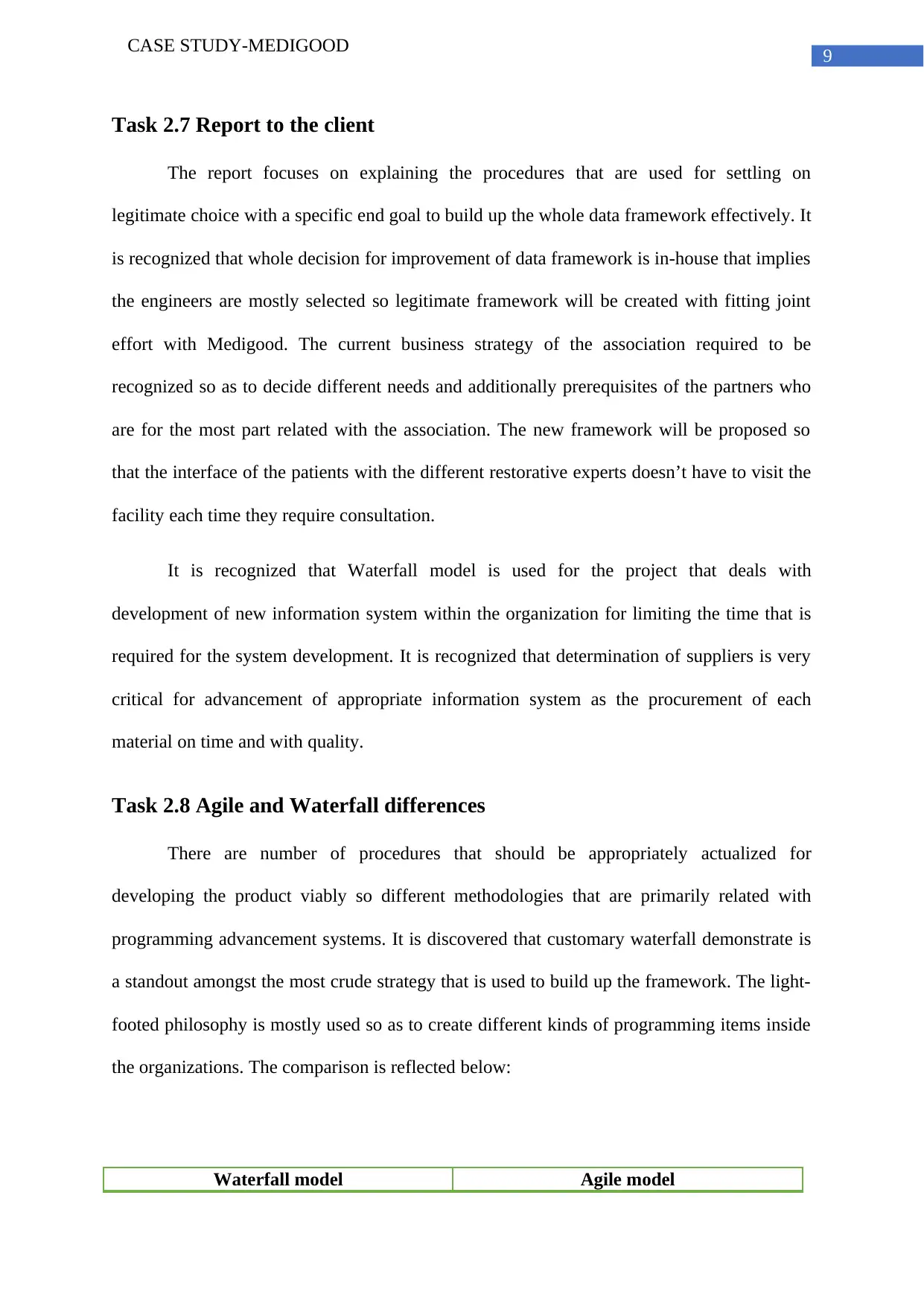
9
CASE STUDY-MEDIGOOD
Task 2.7 Report to the client
The report focuses on explaining the procedures that are used for settling on
legitimate choice with a specific end goal to build up the whole data framework effectively. It
is recognized that whole decision for improvement of data framework is in-house that implies
the engineers are mostly selected so legitimate framework will be created with fitting joint
effort with Medigood. The current business strategy of the association required to be
recognized so as to decide different needs and additionally prerequisites of the partners who
are for the most part related with the association. The new framework will be proposed so
that the interface of the patients with the different restorative experts doesn’t have to visit the
facility each time they require consultation.
It is recognized that Waterfall model is used for the project that deals with
development of new information system within the organization for limiting the time that is
required for the system development. It is recognized that determination of suppliers is very
critical for advancement of appropriate information system as the procurement of each
material on time and with quality.
Task 2.8 Agile and Waterfall differences
There are number of procedures that should be appropriately actualized for
developing the product viably so different methodologies that are primarily related with
programming advancement systems. It is discovered that customary waterfall demonstrate is
a standout amongst the most crude strategy that is used to build up the framework. The light-
footed philosophy is mostly used so as to create different kinds of programming items inside
the organizations. The comparison is reflected below:
Waterfall model Agile model
CASE STUDY-MEDIGOOD
Task 2.7 Report to the client
The report focuses on explaining the procedures that are used for settling on
legitimate choice with a specific end goal to build up the whole data framework effectively. It
is recognized that whole decision for improvement of data framework is in-house that implies
the engineers are mostly selected so legitimate framework will be created with fitting joint
effort with Medigood. The current business strategy of the association required to be
recognized so as to decide different needs and additionally prerequisites of the partners who
are for the most part related with the association. The new framework will be proposed so
that the interface of the patients with the different restorative experts doesn’t have to visit the
facility each time they require consultation.
It is recognized that Waterfall model is used for the project that deals with
development of new information system within the organization for limiting the time that is
required for the system development. It is recognized that determination of suppliers is very
critical for advancement of appropriate information system as the procurement of each
material on time and with quality.
Task 2.8 Agile and Waterfall differences
There are number of procedures that should be appropriately actualized for
developing the product viably so different methodologies that are primarily related with
programming advancement systems. It is discovered that customary waterfall demonstrate is
a standout amongst the most crude strategy that is used to build up the framework. The light-
footed philosophy is mostly used so as to create different kinds of programming items inside
the organizations. The comparison is reflected below:
Waterfall model Agile model
Paraphrase This Document
Need a fresh take? Get an instant paraphrase of this document with our AI Paraphraser
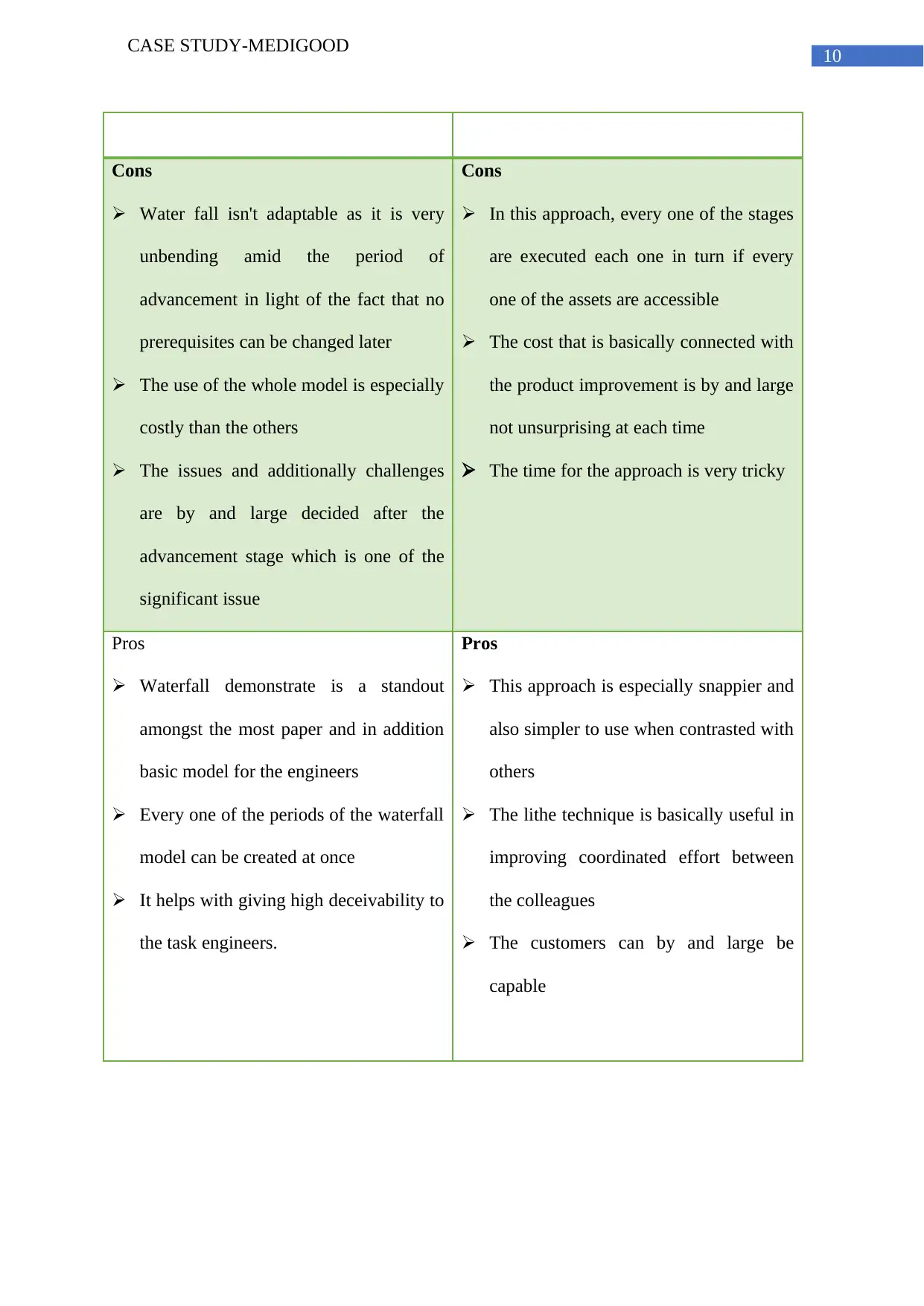
10
CASE STUDY-MEDIGOOD
Cons
Water fall isn't adaptable as it is very
unbending amid the period of
advancement in light of the fact that no
prerequisites can be changed later
The use of the whole model is especially
costly than the others
The issues and additionally challenges
are by and large decided after the
advancement stage which is one of the
significant issue
Cons
In this approach, every one of the stages
are executed each one in turn if every
one of the assets are accessible
The cost that is basically connected with
the product improvement is by and large
not unsurprising at each time
The time for the approach is very tricky
Pros
Waterfall demonstrate is a standout
amongst the most paper and in addition
basic model for the engineers
Every one of the periods of the waterfall
model can be created at once
It helps with giving high deceivability to
the task engineers.
Pros
This approach is especially snappier and
also simpler to use when contrasted with
others
The lithe technique is basically useful in
improving coordinated effort between
the colleagues
The customers can by and large be
capable
CASE STUDY-MEDIGOOD
Cons
Water fall isn't adaptable as it is very
unbending amid the period of
advancement in light of the fact that no
prerequisites can be changed later
The use of the whole model is especially
costly than the others
The issues and additionally challenges
are by and large decided after the
advancement stage which is one of the
significant issue
Cons
In this approach, every one of the stages
are executed each one in turn if every
one of the assets are accessible
The cost that is basically connected with
the product improvement is by and large
not unsurprising at each time
The time for the approach is very tricky
Pros
Waterfall demonstrate is a standout
amongst the most paper and in addition
basic model for the engineers
Every one of the periods of the waterfall
model can be created at once
It helps with giving high deceivability to
the task engineers.
Pros
This approach is especially snappier and
also simpler to use when contrasted with
others
The lithe technique is basically useful in
improving coordinated effort between
the colleagues
The customers can by and large be
capable
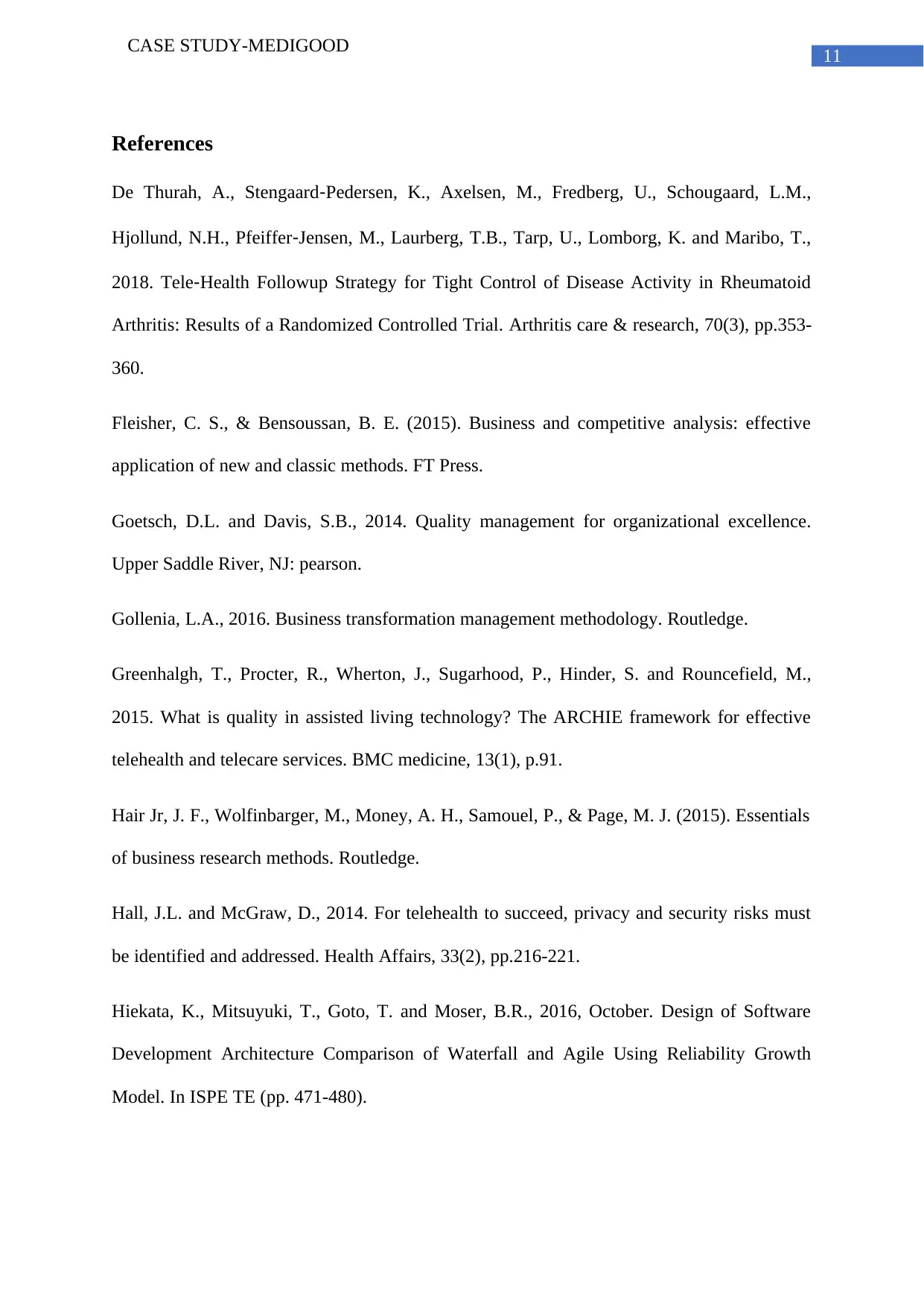
11
CASE STUDY-MEDIGOOD
References
De Thurah, A., Stengaard‐Pedersen, K., Axelsen, M., Fredberg, U., Schougaard, L.M.,
Hjollund, N.H., Pfeiffer‐Jensen, M., Laurberg, T.B., Tarp, U., Lomborg, K. and Maribo, T.,
2018. Tele‐Health Followup Strategy for Tight Control of Disease Activity in Rheumatoid
Arthritis: Results of a Randomized Controlled Trial. Arthritis care & research, 70(3), pp.353-
360.
Fleisher, C. S., & Bensoussan, B. E. (2015). Business and competitive analysis: effective
application of new and classic methods. FT Press.
Goetsch, D.L. and Davis, S.B., 2014. Quality management for organizational excellence.
Upper Saddle River, NJ: pearson.
Gollenia, L.A., 2016. Business transformation management methodology. Routledge.
Greenhalgh, T., Procter, R., Wherton, J., Sugarhood, P., Hinder, S. and Rouncefield, M.,
2015. What is quality in assisted living technology? The ARCHIE framework for effective
telehealth and telecare services. BMC medicine, 13(1), p.91.
Hair Jr, J. F., Wolfinbarger, M., Money, A. H., Samouel, P., & Page, M. J. (2015). Essentials
of business research methods. Routledge.
Hall, J.L. and McGraw, D., 2014. For telehealth to succeed, privacy and security risks must
be identified and addressed. Health Affairs, 33(2), pp.216-221.
Hiekata, K., Mitsuyuki, T., Goto, T. and Moser, B.R., 2016, October. Design of Software
Development Architecture Comparison of Waterfall and Agile Using Reliability Growth
Model. In ISPE TE (pp. 471-480).
CASE STUDY-MEDIGOOD
References
De Thurah, A., Stengaard‐Pedersen, K., Axelsen, M., Fredberg, U., Schougaard, L.M.,
Hjollund, N.H., Pfeiffer‐Jensen, M., Laurberg, T.B., Tarp, U., Lomborg, K. and Maribo, T.,
2018. Tele‐Health Followup Strategy for Tight Control of Disease Activity in Rheumatoid
Arthritis: Results of a Randomized Controlled Trial. Arthritis care & research, 70(3), pp.353-
360.
Fleisher, C. S., & Bensoussan, B. E. (2015). Business and competitive analysis: effective
application of new and classic methods. FT Press.
Goetsch, D.L. and Davis, S.B., 2014. Quality management for organizational excellence.
Upper Saddle River, NJ: pearson.
Gollenia, L.A., 2016. Business transformation management methodology. Routledge.
Greenhalgh, T., Procter, R., Wherton, J., Sugarhood, P., Hinder, S. and Rouncefield, M.,
2015. What is quality in assisted living technology? The ARCHIE framework for effective
telehealth and telecare services. BMC medicine, 13(1), p.91.
Hair Jr, J. F., Wolfinbarger, M., Money, A. H., Samouel, P., & Page, M. J. (2015). Essentials
of business research methods. Routledge.
Hall, J.L. and McGraw, D., 2014. For telehealth to succeed, privacy and security risks must
be identified and addressed. Health Affairs, 33(2), pp.216-221.
Hiekata, K., Mitsuyuki, T., Goto, T. and Moser, B.R., 2016, October. Design of Software
Development Architecture Comparison of Waterfall and Agile Using Reliability Growth
Model. In ISPE TE (pp. 471-480).
⊘ This is a preview!⊘
Do you want full access?
Subscribe today to unlock all pages.

Trusted by 1+ million students worldwide
1 out of 14
Related Documents
Your All-in-One AI-Powered Toolkit for Academic Success.
+13062052269
info@desklib.com
Available 24*7 on WhatsApp / Email
![[object Object]](/_next/static/media/star-bottom.7253800d.svg)
Unlock your academic potential
Copyright © 2020–2025 A2Z Services. All Rights Reserved. Developed and managed by ZUCOL.



